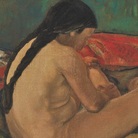Ferdinando Ongania. Luce su Venezia. Viaggio nella fotografia dell’Ottocento

Dal 12 April 2014 al 2 November 2014
Stra | Venezia
Luogo: Museo Nazionale di Villa Pisani
Indirizzo: via Doge Pisani 7
Orari: 9-20. Dal 1 ottobre 9-17; chiuso il lunedì
Curatori: Myriam Zerbi, Sabina Vianello
Enti promotori:
- Soprintendenza per i Beni Architettonici e Paesaggistici per le Province di Venezia Belluno Padova e Treviso
Costo del biglietto: Villa + Parco + Mostra: intero € 10, ridotto € 7.50, gratuito per cittadini UE fino ai 18 anni e oltre i 65
Telefono per informazioni: +39 049 502074
E-Mail info: sbap-vebpt.villapisani@beniculturali.it
Sito ufficiale: http://www.villapisani.beniculturali.it
Ferdinando Ongania è stato senza dubbio il più grande editore veneziano nel passaggio del secolo, geniale e brillante erede della tradizione tipografica del celebre Aldo Manuzio che aveva fatto di Venezia, “luogo più simile a un mondo intero che a una città”, il maggior centro editoriale europeo tra Quattrocento e Cinquecento. Documentando l’evoluzione dei modi e delle forme della fotografia di paesaggio veneziana tra seconda metà dell’Ottocento e primi decenni del Novecento, come editore, Ongania segna una tappa fondamentale nel consolidare e avvalorare il percorso della ‘scrittura di luce’ (photo-grafia) come ritratto urbano, creando, con Calli e canali, uno straordinario ‘monumento di carta’ alla Venezia di fine Ottocento e alla sua realtà sociale.
Sono duecento i preziosi originali ottocenteschi, foto-incisioni che registrano fedelmente l’immagine della città, dei luoghi con i campi, le calli, le isole, restituendone in maniera dettagliata e icastica la maestosità dei palazzi a specchio sull’acqua e delle aree monumentali rese celebri dal vedutismo che, da Canaletto in poi, ne fa icone cittadine. Accanto a Piazza San Marco, al Ponte dei Sospiri, al Canal Grande e al ponte di Rialto, appaiono angoli meno noti di una “Venezia minore”, Santa Marta come San Pietro di Castello, luoghi che pittori e fotografi andavano scoprendo e frequentando, sulla scia della poetica del vero sviluppatasi nella seconda parte del secolo XIX. La gloriosa storia della Serenissima si lega, negli scatti scelti da Ongania a raccontare la sua Venezia, alla realtà quotidiana della vita contemporanea con velieri che solcano le acque del bacino di San Marco, personaggi che si spostano in gondola protetti dal felze, pescatori in Canale della Giudecca, signore che passeggiano in Piazzetta con gli ombrelli parasole. La “nuova visione” fotografica va fissando in quegli anni nuovi modi di guardare al paesaggio veneziano, lontano dagli stereotipi noti, nei silenzi della laguna, dalle barche di pescatori tra le barene e le isole di Murano, Burano e Torcello come delle Vignole, Mazzorbo o di San Francesco del deserto.
Nel negozio che aveva le vetrine nel sottoportego della Piazza, ai numeri 72, 73 e 74 dell’Ala Napoleonica, aperto sul finire degli anni Quaranta dal tedesco Hermann Friedrich Münster, Ongania inizia a lavorare da ragazzo, diventando, da commesso, direttore della ditta, e rilevandone infine l’attività nel 1871. Nel suo atelierOngania vende libri d’antiquariato, incisioni antiche, dipinti di artisti contemporanei e fotografie del tempo, oltre a oggetti d’arte di vario genere e lavori d’antiquariato, contando su una rete di rapporti diretti con numerosi collezionisti. Con i proventi di questa attività si dedica all’editoria di libri d’arte illustrati, raggiungendo nel campo risultati sorprendenti.
La fucina di Ongania, dove si trova persino una saletta per fare musica, ricordata da John Ruskin nel suo The Stones of Venice, diviene un frequentato punto d’incontro per artisti, scrittori, bibliofili e studiosi italiani e stranieri, luogo prescelto da personaggi quali John Ruskin, Pompeo Molmenti, Pietro Selvatico, Alvise Zorzi e Camillo Boito, che si ritrovano insieme accendendo il dibattito sull’emergenza di conservazione e restauro di Venezia e dei suoi monumenti e sulla necessità di tutela del patrimonio artistico e architettonico cittadino che deve cominciare dall’accurato studio e dalla documentazione dei beni che deve essere quanto più esatta e obiettiva possibile.
Messo in luce nel dibattito culturale del tempo il ruolo della fotografia, vissuta allora come scienza oltre che come arte, e il valore del nuovo mezzo nella rappresentazione del paesaggio urbano con le sue potenzialità di farsi testimonianza viva e realista, Ferdinando Ongania concepisce e avvia il progetto di far fotografare i luoghi della città con i suoi abitanti e produce le prime importanti raccolte fotografiche dell’epoca che uniscono all’indubbio valore documentario il gusto estetico di tagli sapienti e studiati giochi di luci e ombre che conferiscono agli scatti un sapore di suggestiva bellezza.
In mostra le 200 foto-incisioni originali che compongono la duplice collezione Ongania Calli e canali e Calli, canali e isole della laguna, una galleria di preziosi originali ottocenteschi che documentano per intero l’impresa di Ongania, facendo rivivere il racconto della Venezia di fine Ottocento in un suggestivo ritratto della città e della realtà sociale del tempo.
Il Museo Nazionale di Villa Pisani è da anni impegnato nella valorizzazione e divulgazione del patrimonio artistico dell’Ottocento veneto, e ha acquisito in questo filone una riconosciuta specificità espositiva con le mostre Emma Ciardi 1879-1933. Impressionismo Veneziano (2009); Ottocento veneziano (2010); Paesaggi d’acqua. Luci e Riflessi nella pittura veneziana dell’800 (2011); Nobiltà del lavoro. Arti e Mestieri nella pittura veneta tra 800 e 900 (2012); Venezia tra Ottocento e Novecento nelle fotografie di Tomaso Filippi (2013).
La mostra è promossa dalla Soprintendenza per i Beni Architettonici e Paesaggistici per le province di Venezia, Belluno, Padova e Treviso, diretta da Antonella Ranaldi, ha sede al Museo Nazionale di Villa Pisani a Stra (Venezia), diretto da Giuseppe Rallo, è organizzata da Munus, società concessionaria dei servizi aggiuntivi a Villa Pisani ed è curata da Myriam Zerbi e Sabina Vianello. La mostra è organizzata in collaborazione con l’Archivio Carlo Montanaro e con l’Università IUAV di Venezia.
Domenica 7 settembre alle ore 11 la premiazione del concorso fotografico legato alla mostra.
SCARICA IL COMUNICATO IN PDF

-
 Dal 12 September 2025 al 11 January 2026
Torino | Palazzo Falletti di Barolo
Dal 12 September 2025 al 11 January 2026
Torino | Palazzo Falletti di Barolo
BRUNO BARBEY. Gli Italiani
-
 Dal 10 September 2025 al 11 January 2026
Vercelli | Chiesa di S. Marco – Spazio ARCA
Dal 10 September 2025 al 11 January 2026
Vercelli | Chiesa di S. Marco – Spazio ARCA
Guttuso, De Pisis, Fontana… L’Espressionismo Italiano
-
 Dal 6 September 2025 al 25 January 2026
Roma | Museo Storico della Fanteria
Dal 6 September 2025 al 25 January 2026
Roma | Museo Storico della Fanteria
Gauguin. Il diario di Noa Noa e altre avventure
-
 Dal 6 September 2025 al 11 January 2026
Livorno | Villa Mimbelli
Dal 6 September 2025 al 11 January 2026
Livorno | Villa Mimbelli
Giovanni Fattori. Una rivoluzione in pittura
-
 Dal 21 August 2025 al 21 September 2025
Bologna | Palazzo Pallavicini
Dal 21 August 2025 al 21 September 2025
Bologna | Palazzo Pallavicini
Jack Vettriano
-
 Dal 7 August 2025 al 9 November 2025
Pesaro | Musei Civici di Palazzo Mosca
Dal 7 August 2025 al 9 November 2025
Pesaro | Musei Civici di Palazzo Mosca
Nino Caffè. Tra naturalismo e satira


